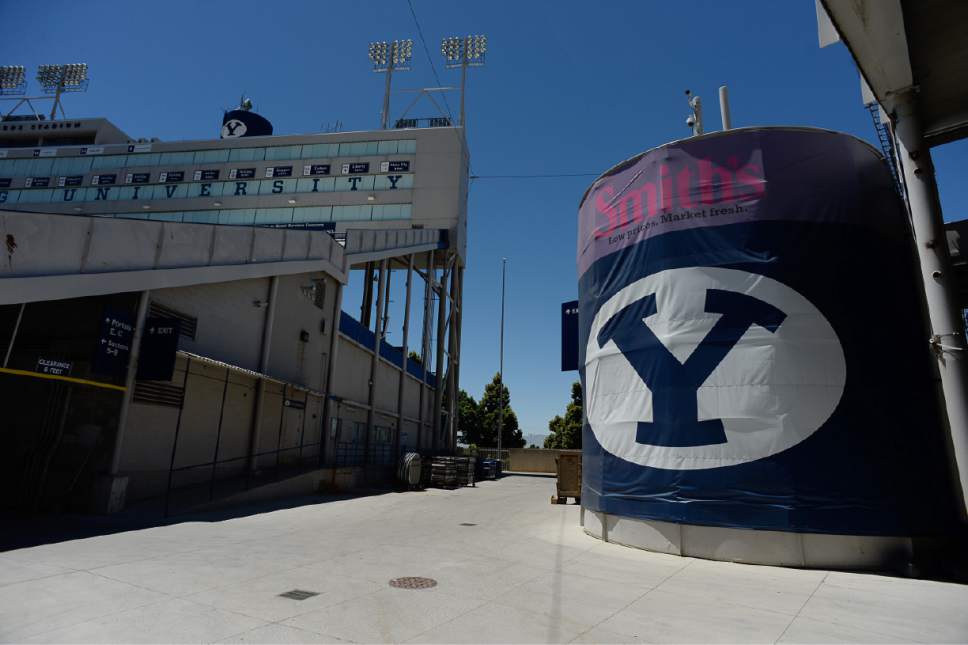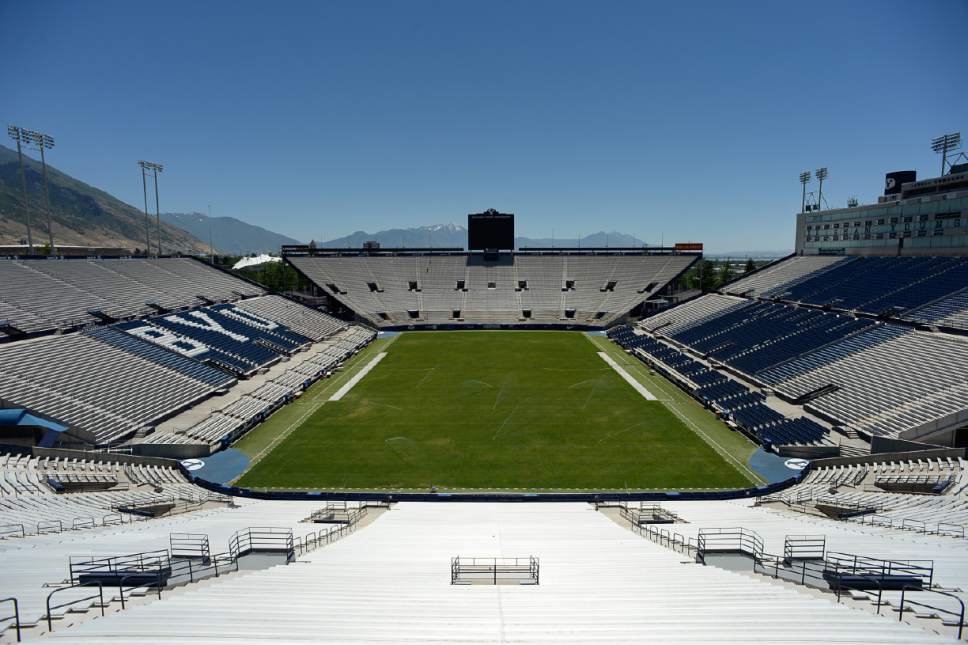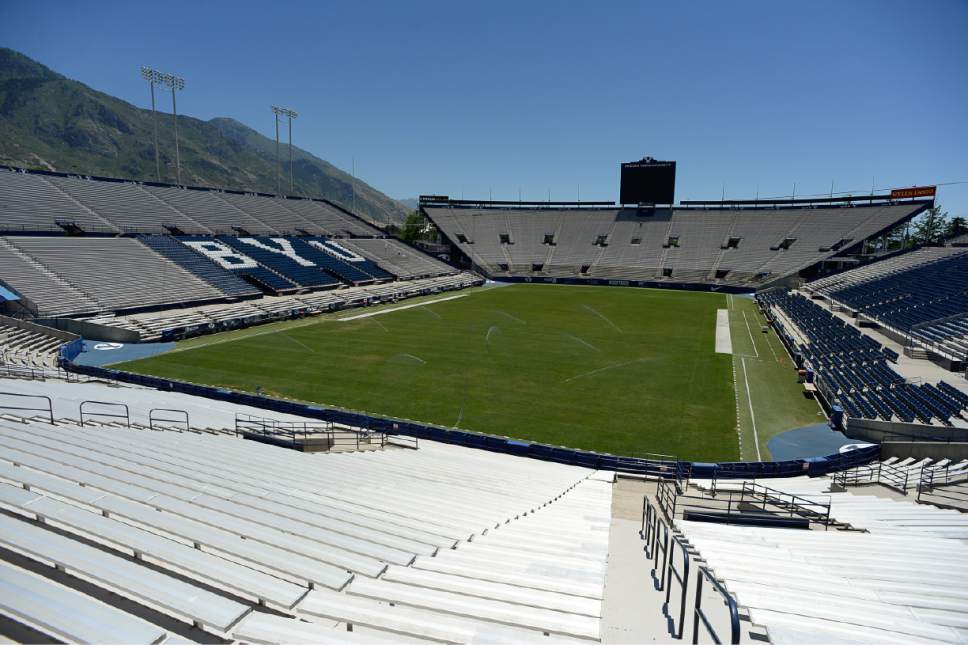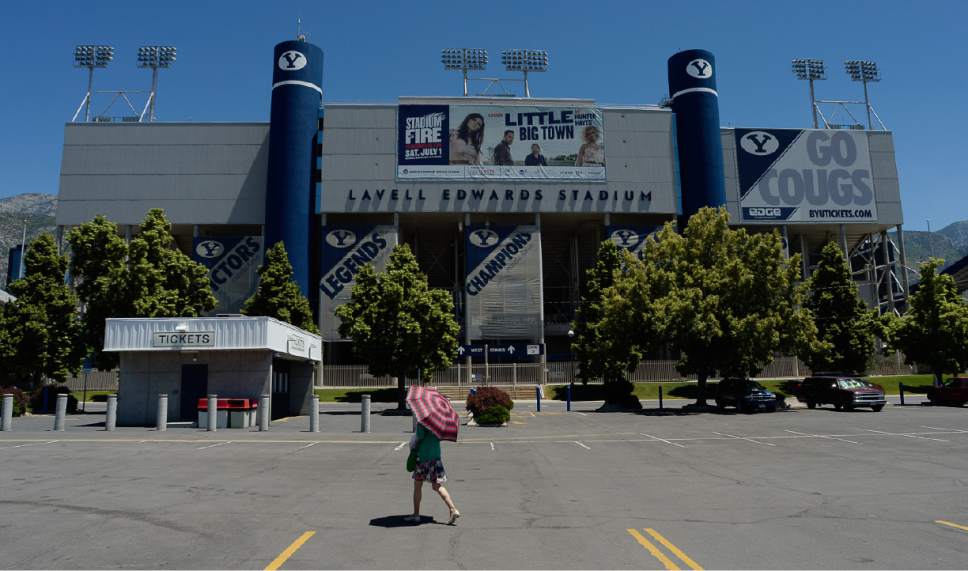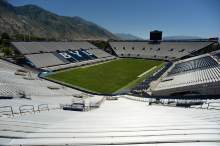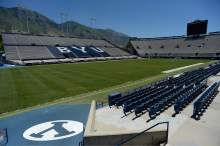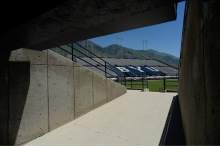This is an archived article that was published on sltrib.com in 2017, and information in the article may be outdated. It is provided only for personal research purposes and may not be reprinted.
Provo • BYU's football stadium as it is presently constituted turns 35 this fall, having last undergone a major expansion in 1982 when Cougar Stadium's capacity was increased from 35,000 to 65,000.
Nothing official is in the works to mark the 35th birthday of the venue, which was renamed LaVell Edwards Stadium in 2000 to honor the late, legendary coach before his final home game. Edwards died last December at the age of 86.
Also, there are no immediate plans to expand the stadium, several BYU officials confirmed. But upgrades are coming, especially for those attached to their mobile devices.
Stadium expansion is a topic in Provo, mostly among fans, despite only a few sellouts the past five seasons. That's partly because rival Utah announced in March that it will conduct a feasibility study for the expansion of 45,807-seat Rice-Eccles Stadium, which has sold out for 38 consecutive games, and the Cougars have always enjoyed the distinction of hosting the largest basketball and football crowds in the state.
Instead of making LES bigger, the focus is on making it better, athletic director Tom Holmoe said in March.
"Looking at it practically, right now we don't sell out," Holmoe said. "So it would be silly to put in another 20,000 more seats, because the 20,000 more seats you put in would be in the corners. … If you want to put an upper deck on, that would be great. I can picture an upper deck, but probably not [during] my administration. It would look great, though."
The stadium's capacity is now 63,470 after wheelchair accessible seating and upgraded club seating was added in 2011. The problem is that nearly half the seats — some 30,000 — are behind the end zones. Only about 32,000 seats — 16,000 on each side — are considered prime, sideline seats. The remainder are in the 42 luxury suites, also called loges, in the four-story press box.
"The big thing for us right now is not necessarily seats," Holmoe said. "It is hospitality. Those are the things that we are turning our attention to: hospitality and making it really a place where people come for social [activities] and hospitality. It used to be all about the game. Now, people, including our students, come to see things other than the game."
Added Duff Tittle, BYU's Associate Athletic Director for Communications: "We think the size of the stadium is at a pretty good number right now. What is really important in college football right now is the experience that fans get while they are there. And that's what we've been spending a lot of our time, energy and resources on, to make sure we are providing a great overall game-day experience."
Special Events Director Justin Durfey, who oversees the stadium and the Marriott Center, reiterated Holmoe's March comments last week. He is not aware of any major upgrades or facelifts for the football stadium planned for the future, but insists that many have happened recently that many fans may not be aware of.For instance, larger, state-of-the-art video walls and matrix ribbon boards were added to the north and sound end zones in 2012, and a television platform was added to the southwest corner for BYUtv's pre- and post-game broadcasts. A new air conditioning system was installed in the press box in 2015, enabling different areas to set their own desired temperatures. More concession choices have been made available, and more may be coming, including sushi, Durfey said. Whether caffeinated drinks will ever be sold at the MC or LES is a decision made "at a way higher level than me," the director said.
"The university has made the commitment to the football stadium, and we are doing our best to make what we have last, and make it better, so that people will be comfortable when they come to the games," Durfey said. "If you look at the whole sports and entertainment industry, the demand for any kind of upgraded experience continues to increase. … We are trying to give people an excuse to get away from their TV, get off the couch and come to the games, so we are doing everything we can to make it an enjoyable experience."
That includes a better experience with mobile devices.
Tittle said the wireless connectivity situation at the stadium continues to improve and will be even better this coming season. Last fall, Verizon Wireless installed a Distributed Antenna System (DAS) and this year T-Mobile and AT&T are expected to follow suit, although that may not happen until after the opener Aug. 26 against Portland State.
Tittle said BYU officials are "getting really close" to signing a deal with a Wi-Fi network to provide coverage in the entire stadium.
"Once you have a DAS and a Wi-Fi system, now you have a real rich user environment in your stadium, and people can get on their phones and do just about anything, because the phones can use both systems," Tittle said. "We are getting there. It will be a good thing."
Although artificial turf is being installed next door at the baseball stadium, neither Holmoe, Durfey nor Tittle see the fake stuff ever replacing the grass at LaVell Edwards Stadium.
"We like the grass we have right now," Tittle said. "We've had it for a few years, and once the roots took hold it has been great. It drains really well, and it works for us, so there has never been much talk about going to artificial turf in the football stadium." Important dates in history of BYU's football stadium
1964 • Opens at current site on north end of campus as Cougar Stadium with a capacity of 28,812 seats, replacing a 5,000-seat venue to the south
1968 • Bleacher seats added to the end zones increased capacity to 35,000
1982 • Major renovation and expansion increases capacity to 65,000. Track is removed, field is dropped 8 feet, additional rows are added along both sidelines and a four-story press box with 42 luxury suites (loges) is built on west side
1990 • Behind future Heisman Trophy winning QB Ty Detmer, BYU upsets No. 1-ranked Miami 28-21 in the home opener on Sept. 8, 1990 1993 • Largest crowd to ever assemble in the state of Utah (66,247) watches Notre Dame defeat BYU 45-20 on Oct. 16, 1993 1996 • Large video wall is added to the south end zone and a matrix scoreboard to the north end zone
2000 • LDS Church president Gordon B. Hinckley announces Cougar Stadium will be renamed LaVell Edwards Stadium to honor the legendary coach at his final home game, a 37-13 win over New Mexico
2003 • Seating capacity is reduced to 64,045 as luxury legacy seating is added to the east side
2008 • A second large video board replaces the matrix board in the north end zone, marching band facilities added under west stands
2011 • Upgraded club seating and wheelchair accessible seating drops seating to its current capacity of 63,470
2012 • Larger, state-of-art LED video walls and matrix ribbon boards added to north and sound end zones, television platform added to southwest corner
2016 • Verizon cellular Distributed Antenna System (DAS) installed to improve cell phone service throughout stadium, Cougar room renovated
2017 • Cell phone service providers T-Mobile and AT&T expected to install DAS for their customers before opener on Aug. 26 against Portland State, or shortly after


